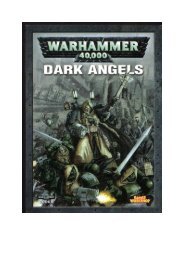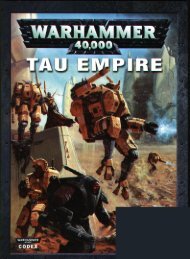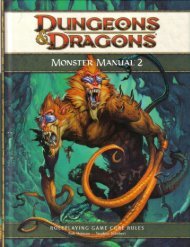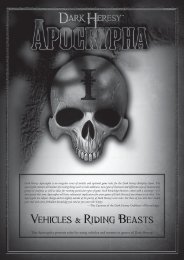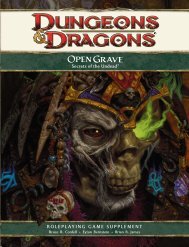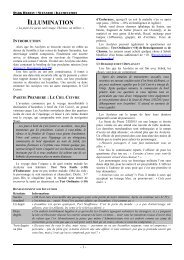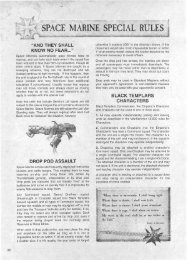Create successful ePaper yourself
Turn your PDF publications into a flip-book with our unique Google optimized e-Paper software.
Also at this age, <strong>dragons</strong> begin to contemplatelong-term schemes. Although they devote less time toscheming than elder <strong>dragons</strong> do, they might establishcontacts within nearby communities or merchantorganizations, the better to learn when and wheregreat treasures will become available. Their negotiatingstrategies boil down to bribery or threats, ratherthan the elaborate manipulations and deceptionsemployed by more powerful wyrms.Adult <strong>dragons</strong> seek to expand their territoriesdramatically or even to move their lairs, abandoningwhatever haphazard sanctuary they might havefound as youths in favor of larger, more comfortable,or even custom-built homes. These efforts sometimespit them against other <strong>dragons</strong> or territorial monsters.Thus, adult <strong>dragons</strong> are the most likely to initiatecombat with other wyrms.ElderBy the time it becomes an elder, a dragon has likelyfound or created its permanent lair. It has gathered asizable hoard—one that might already have attracteda number of adventurers—and it has well and trulyestablished its territory. Although a few elder <strong>dragons</strong>continue to expand their domains, most are contentwith their holdings (barring environmental changesor famine) and are more likely to be the defenderagainst encroaching younger <strong>dragons</strong> than they are toinitiate such conflicts.Elder <strong>dragons</strong> have lived long enough that theyhave fully adopted the long view in terms of theirgoals and efforts. They have gathered minions—sometimes veritable armies of them—and know wellthe sizes and capabilities of all the humanoid communitieswithin, and bordering on, their territories.They might make efforts to influence the developmentof said communities, either overtly—throughthreats and demands—or in secret, manipulatingagents within the local power structure. Whenadventurers discover that the king’s vizier, the highpriest, and the local guild-masters are all puppetsof a dragon pulling strings behind the scenes, oddsare good that the dragon is an elder. Some <strong>dragons</strong>engage in such manipulative practices to siphon offthe wealth of a city or small kingdom; some do itout of desire for power and authority; some are justbored.AncientBy the time it becomes ancient, a dragon ranksamong the most powerful creatures to walk the earth.Its lair is nigh impregnable. Its hoard contains morewealth than any kingdom since the fall of the greatempires. Its name (or at least one of them) is knownfar and wide among <strong>dragons</strong> and humanoids both.The dragon has survived longer than most nations.The truth is, the dragon doesn’t have much left todo. The dragon’s territory is as large as the dragonwants it to be. If the dragon wants to manipulateand control the nearby communities, it does so. Fewrivals exist with sufficient power to offer the dragonanything resembling sport. For an ancient dragon,perhaps the greatest challenge is staving off ennui.Some ancients spend years hibernating or countingand recounting their hoards, for lack of anythingbetter to do. Others ignite conflict, invading other<strong>dragons</strong>’ territories or inspiring mortal allies to go towar, in hopes of finding a challenge to pass the time.A few revert to behaviors of younger <strong>dragons</strong>, huntingand raiding at whim. Some devote themselves fanaticallyto whatever religious beliefs they hold, or seekout new ones.Others take on strange or surprising hobbies, passingthe years by studying select periods in history,mastering rituals, or researching other planes. Whenadventurers hear about a dragon seeking an ancientritual or kidnapping a sage and stealing his library,the dragon might be an ancient seeking a new area ofinterest.TwilightEven <strong>dragons</strong> eventually succumb to the ravages ofage. As death approaches, the wyrm enters a stateknown to sages as “the twilight.” (What the <strong>dragons</strong>call this period, if anything, is unknown.) Althoughthe average age of a twilight dragon is within a coupleof decades of maximum age, some <strong>dragons</strong> enter thetwilight more than a century earlier. Others entertwilight only in the last few years of life. Some neverenter twilight, going overnight from full, ancienthealth to death of old age.Twilight is the only time during a dragon’s lifespan when the creature grows weaker rather thanstronger. Precisely how this weakening develops differsfrom dragon to dragon and appears to have nocorrelation with the dragon’s variety. For DMs whowish to run a dragon in its twilight years, considerone or more of the following options, or make up yourown.✦ The dragon grows less viable in all respects. Usethe rules on page 174 of the Dungeon Master’s Guide(“Increasing or Decreasing Level”) to lower thedragon’s level by one to three.✦ The dragon finds it harder to recharge its abilities.Choose either the breath weapon or another abilitythat recharges on a d6 roll, and treat it as a onceper-encounterability instead.✦ The dragon’s senses begin to fail. It takes a penaltyof –2 to –10 to Perception checks and Insightchecks, and –1 to –5 to initiative checks.16CHAPTER 1 | Dragon Lore



